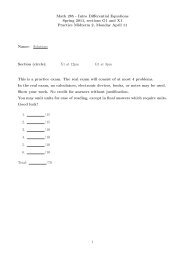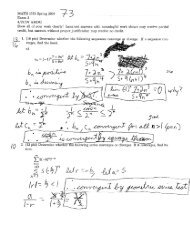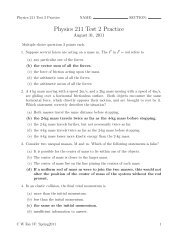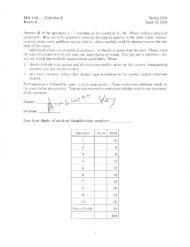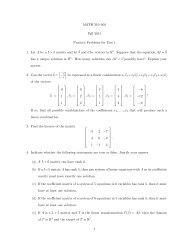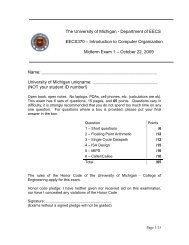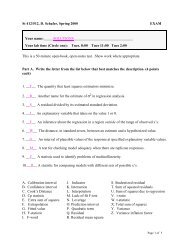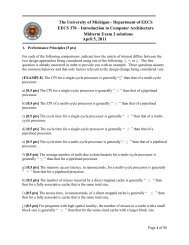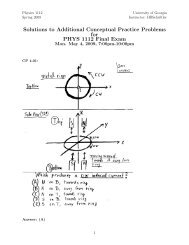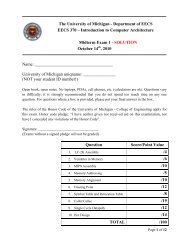Midterm Exam CMPSCI 453: Computer Networks Fall 2010 Prof. Jim ...
Midterm Exam CMPSCI 453: Computer Networks Fall 2010 Prof. Jim ...
Midterm Exam CMPSCI 453: Computer Networks Fall 2010 Prof. Jim ...
Create successful ePaper yourself
Turn your PDF publications into a flip-book with our unique Google optimized e-Paper software.
<strong>Midterm</strong> <strong>Exam</strong><strong>CMPSCI</strong> <strong>453</strong>: <strong>Computer</strong> <strong>Networks</strong><strong>Fall</strong> <strong>2010</strong><strong>Prof</strong>. <strong>Jim</strong> KuroseInstructions: Please use two exam blue books – answer questions 1, 2 in one book, and the remainingtwo questions in the second blue book. Put your name and student number on the exam books NOW! The exam is closed book. You have 80 minutes to complete the exam. Be a smart exam taker - if you get stuck onone problem go on to another problem. Also, don't waste your time giving irrelevant (ornot requested) details. The total number of points for each question is given in parenthesis. There are 100 pointstotal. An approximate amount of time that would be reasonable to spend on each questionis also given; if you follow the suggested time guidelines, you should finish with 10minutes to spare. The exam is 80 minutes long. Show all your work. Partial credit is possible for an answer, but only if you show theintermediate steps in obtaining the answer. Good luck.
Question 1: ``Quickies'' (32 points, 20 minutes)Note: Four points each (pretty much right or wrong)Answer each of the following questions briefly, i.e., in at most a few sentences.a) Suppose there are 5 users whose traffic is being multiplexed over a single link with acapacity of 1 Mbps.1) Suppose each user generates 100 kbps when busy, but is only busy (i.e., hasdata to send) 10% of the time. Would circuit-switching or packet-switching bepreferable in this scenario? Why? Answer: Here, circuit switching ispreferable since each of the users will each get a dedicated allocation of 100kbps.2) Now suppose that the link capacity is still 1 Mbps, but the amount of trafficeach user has to send when busy is increased to 1 Mbps, and that each of the 5users still only has data to send 10% of the time. Would circuit-switching orpacket-switching be preferable in this scenario? Why? Answer: Here, packetswitching is preferable. We can not allocate 1Mbps per user in circuitswitchingmode. Packet switching will work well since the aggregate averagetraffic rate is 0.5 Mbps and the link is a 1 Mbps linkb) What is the purpose of the IF-MODIFIED-SINCE field in an HTTP GET message?Answer: The HTTP server will only send the requested content if the content has beenchanged after the date specified in the IF-MODIFIED-CINE field.c) Suppose a TCP SYN message is sent from a client with IP address 128.119.40.186and client port number 5345 to a server with IP address 41.123.7.94 and server portnumber 80 (HTTP)1) Once the TCP connection has been established, what will be the client-side IPaddress, client-side port number, server-side IP address and server-side portnumber of the TCP segment carrying the HTTP GET message. Answer:exactly as specified in the problem statement.2) Will the TCP SYN message and the HTTP GET message be directed to thesame socket at the server? Explain in one or two sentences. Answer: NO. TheGET will be directed to the new socket that was created when the TCP SYNmessages was accepted (i.e., the socket returned from the wait on the .accept()on the welcoming socket). Note that the TCP SYN and the GET will both beaddressed to port 80 on the server, however.d) In network-assisted congestion control, how is congestion in the network signaled tothe sender? Answer: the routers may set bits in passing packets, and may sendmessages to the source or destination to indicated congestion. Name one protocol thatuses a network-assisted approach. Answer: ATM ABR uses a network-assistedapproach. In end-end congestion control, how is congestion in the network signaledto the sender? Answer: congestion is inferred at the end hosts (sender or receiver,either as a the result of packet loss or increased delay). Name one protocol that usesan end-end approach. Answer: TCP uses an end-end approach.e) Briefly describe (in a few sentences) how caching is used in the DNS (note: you arenot being asked to describe the entire DNS). Answer: a host will maintain a cache ofrecent DNS-translated address/name pairs. If a name is found in the cache, the DNSsystem will not be consulted to perform the mapping. Are values returned from a DNS
cache always guaranteed to be up to date? Explain. Answer: NO. Cached values havea time-to-live value and will remain in the cache until they time out. If thename/address pair is changed in the DNS, the cached value will not change, and thecurrent mapping will only become known after the old mapping times out of the cache,and a new mapping is retrieved from the DNS.f) Consider a sliding window reliable data transferprotocol (e.g., Go-Back-N, or Selective-Repeat).Suppose the sender window contains sequencenumbers in the range [x,x+N]. Is it possible for thesender to receive an ACK that is for a sequencenumber that is less than x? Answer: yes see diagram.If so, sketch a scenario showing how this can happen.If this can not happen, explain why this can nothappen.g) Does the Internet checksum always detect errors in theSenderwindow[x-1,x+1][x,x+2][x+1,x+3][x+2,x+4]transmitted segment? Explain your answer in a sentence or two. Answer: No. Forexample if two 16-bit word values are swapped, this would not be detected since thesum is unchanged.h) What is meant by demultiplexing a protocol data unit up to an upper-level protocol?Answer: this refers to passing the decapsulated data unit up to the appropriate higherlevel protocol. This is done by looking at the upper-layer protocol field.x-1xx+1TIMEOUTResend x-1x+2x+3x+4ACK x-1arrives
Question 2: Delays, Throughput and Caches (18 points, 10 minutes)Consider the scenario in the figure below in which a serveris connected to a router by a 100 Mbps link, with a 100 mspropagation delay. That router in turn is connected to tworouters, each over a 25 Mbps link with a 200 mspropagation delay. A Gbps link connects a host and acache (when present) to each of these routers; this link,being a local area network, has a propagation delay that isessentially zero. All packets in the network are 10,000bits long.server100 Mbps100 ms prop.a) 4 points. What is the end-to-end delay from when acache host cachepacket is transmitted by the server to when it is received at a host? Assume that thereare no caches, that there is no queueing delay at a link, and that the node (router)packet-processing delays are also zero. Answer: If all packets at 10,000 bits long, ittakes 100 usec to send the packet over a 100Mbps link, 400 usec to send over a 25Mbps link, and 10 usec to send over a gigabit link. The sum of the three linktransmissiontimes is thus 510 usec. The sum of the propagation delays is200+100=300 msec. Thus the total end-end delay is 300.510 msec.b) 3 points First assume that client hosts send requests for files directly to the server (i.e.,the caches are off). What is the maximum rate at which the server can deliver data to asingle client, assuming no other clients are making requests. Answer: 25 Mbps, thebottleneck link speed.c) 3 points Again assume that only one client is active, but now suppose the caches areHTTP caches and are turned on. A client HTTP GET is always first directed to itslocal cache. 50% of the requests can be satisfied by the local cache. What is themaximum rate at which this client can receive data in this scenario? Answer: Weassume that requests are serially satisfied. 50 % of the requests can be delivered at 25Mbps and 50% of the requests can be delivered at 1 Gbps. So the average rate is512.5 Mbps.d) 4 points Now suppose that the clients in both LANs are active and the HTTP cachesare on, as in c) above. 50% of the requests can be satisfied by the local cache. What isthe maximum rate at which each client can receive data, in this scenario? Answer: the25 Mbps remains the bottleneck link, which is not shared between clients. So theanswer is the same as c) above. Note that we assume that the 100Mbps is shared at afine grain, so that each client can get up to 50Mbps over that link.e) 4 points . Now suppose the 100 Mbps link is replaced by a 25 Mbps link. Repeatquestion d) above in this new scenario. Answer: The two clients must now share the 25Mbps bottleneck link, each getting 12.5 Mbps. 50 % of the requests from a client aredelivered at 12.5 Mbps and 50% of the requests can be delivers a 1 Gbps. So theaverage rate is 506.25 Mbps.host25 Mbps200 ms prop.1 Gbps0 prop. delay
Question 3: TCP potpourri (20 points, 15 minutes)Answer questions a) – d) below briefly, in just a few sentences. Question e) will take somemore time and thought and require a longer answer.a) (3 points) What is the purpose of the receiver-advertised window in TCP? Answer:this allows the receiver to tell the sender how much unacknowledged data can be inflight.b) (3 points) Identify 6 fields in the TCP header, and give a one-sentence description ofeach of their uses. Answer: souce port, dest port, seq num, ack num, checksum,receiver window, options, SYN, FIN, ACK, urgent pointer, PSH.c) (3 points) Consider two TCP sessions that must share a link’s bandwidth. One of theTCP connections has been running for quite some time and has built up a large TCPsending window. The second connection then starts up with an initially smallwindow. Long term, what will be the relative throughput achieved by these two TCPsessions? Explain. Ans: We saw that TCP will cause two senders to eventually fairlyshare the links bandwidth, so each will eventually have the same size window(assuming their RTT is the same).d) (4 points) Consider a TCP session and a UDP session that must share a link’sbandwidth. Of course, both sessions would ideally like to send as fast as they can.Long term, what will be the relative throughput achieved by these two sessions.Explain. Ans: Since UDP can send as fast as it wants, it can use all of the bandwidth(e.g., in the limit that it sends infinitely fast, as soon as buffer space becomes free in arouter, that buffer will be filled by a UDP segment. TCP segments will always be lost,causing TCP to keeps its window at 1 segment, which when sent is always lost.e) (7 points) Suppose we want to modify TCP so that it counts the number of segmentsthat are lost in transit. What are the difficulties of doing this in TCP? Answer: the keycomplications here are (i) that ACKs are cumulative (and so the sender may never seesome packets individually acked); (ii) premature timeouts result in segments beingresent that were never lost in the first place, and (with acks being cumulative) onecant tell how many of the retransmitted segments are lost.o Because ACKs are cumulative, if the sender gets no ACK for x but gets anACK for x+1, it doesn’t know if x was received and the ack for x was lost, or ifx was lost but a later retransmission of x was received.o A lack of an ACK for x could just mean that the ACK for x is delayed. Supposex is retransmitted. The sender may never see an ACK for the retransmitted xbecause of cumulative ACKs for segments with a higher sequence number thanx.o Because of the ACK-every-other segment behavior of TCP receivers, an ACKmay never be generated for x is x+1 is received soon after x.
Problem 4. A Reliable Balance Updating Protocol (30 points, 25 minutes)Consider the following scenario. A sender is called locally and passed updates to increaseor decrease a stored value that is maintained at a remote receiver (you can think of theseincreases and decreases as deposits and withdrawls from a bank account whose balance ismaintained at the receiver). The sender must communicate with the receiver so that thebalance value stored at the receiver is consistent with the value at the sender side, given theincreases or decreases being requested at the sender side. (Of course, the sender and receivervalues can never be perfectly synchronized since there is a delay between the sender andreceiver).The sender and receiver communicate with each other over channels that can corrupt andlose packets, but will not reorder packets. The delays of the channel are unknown and canvary over time.The sender is invoked by a call to balance_update(update_value) which is analogousto the rdt-send(data) sender-side invocation we saw in the rtd protocols;update_value is a positive or negative number reflecting the increase or decrease(analogous to deposit/withdrawl) to the balance.The receiver should track the value of a variable balance (which starts at 0), which tracksthe value of the balance, and can be positive or negative. The updates at the receiver do notneed to be processed in the order in which there were initially received at the sender, buteventually the value of balance at the receiver must equal the sum of the increases/decreasesmade at the sender via balance_update(new_value), and of course each update requestmade at the sender must be reflected only onceat the receiver.a) Design a protocol between the senderand receiver, operating over the lossyand error-prone channel, to ensure thatthe receiver’s value is as close aspossible to that resulting from thesequence of increases and decreasesmade at the sender. Specify yourprotocol using finite state machines.(Hint: there are many possible correctsolutions here; some are easier than others.You might want to think a bit about how thisbalance-updating problem differs from thereliable in-order data delivery problem thatwe studied in class.). Answer: here is mysolution. Note that there are separate FSMfor sender and receiver (!).b) For each state in your FSM, give a onesentence description of what it means whenthe sender or receiver is waiting in that state.Answer: there is just one wait state in each.senderbalance = 0receive(ACK) &&corrupt(ACK)receiverbalance = 0balance_updatebalance = balance+update_valuesend(balance)start_timersenderwaittimeoutsend(balance)start_timerreceive(ACK) && notcorrupt(ACK)extract(ACK,rbalance)If (rbalance==balance)t tireceive(sender_balance) &&corrupt(sender_balance)receiverwaitreceive(sender_balance) &¬corrupt(sender_balance)extract(sender_balance,balance)send ACK(balance)( )
The sender waits for a call from above (with an update), a timeout (in which case itwill resend), or arrival of a message (which is corrupt or not). The receiver just waitsfor a message from the sender (which is corrupt or not). Note that I didn’t usesequence numbers here since the basic idea is that the sender is simply going to keepupdating values, and will always send the most recent update. By putting updates atthe sender, the receiver simply needs to deliver up correctly received balance values.c) For each type of message sent between sender and receiver, specify the fields in eachtype of message and the values/meaning of each field. Answer: the sender sends thecurrent balance (say a floating point) and will include a CRC to detect bit errors. Thereceiver sends an ACK with the current value of the balance.d) Suppose now that the medium can reorder messages. Give a short description (oneparagraph) of how you would modify you protocol (if at all) to accommodate this.Answer: if the medium reorders the balance at the receiver will always correspond tothe balance at the sender at some point in time. If we need to the balance to bedelivered sequentially at the receiver, we’d need to add sequence numbers that arelarge enough so that wrap around wouldn’t be a problem.e) Suppose now that the link connecting the sender and receiver has a long propagationdelay. Describe in a few sentences how you would modify (if at all) your protocol ina) to accommodate long-delay links. You do not have to provide an FSM, just brieflydescribe (in words) any changes you would make. Answer: for my solution, I wouldn’tchange anything since the sender is always sending the most recent value. If one useda stop-and-wait-sequence-numbered-approach like we used in rdt 3.0, then one wouldwant to add pipelining so that the sender could have multiple updated balanced intransit.




